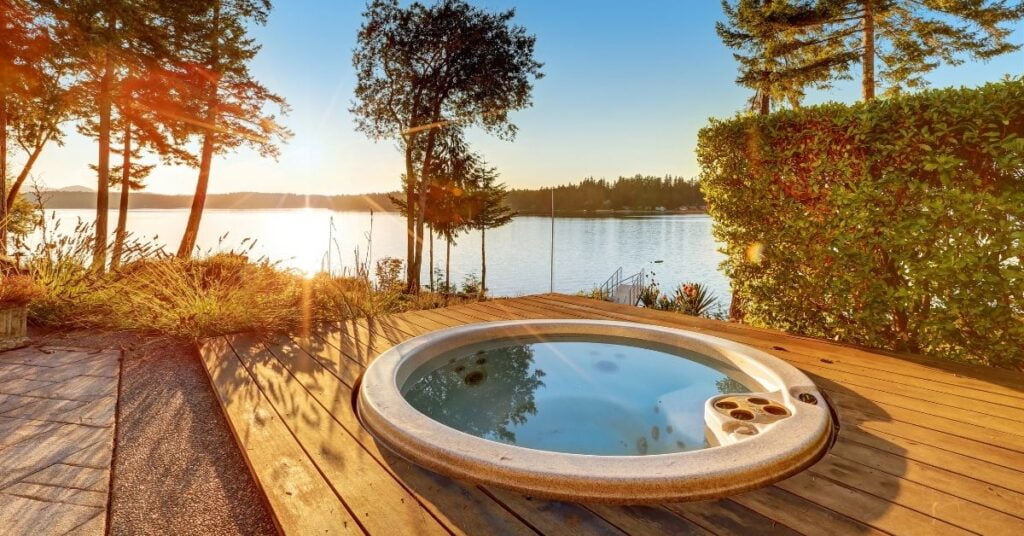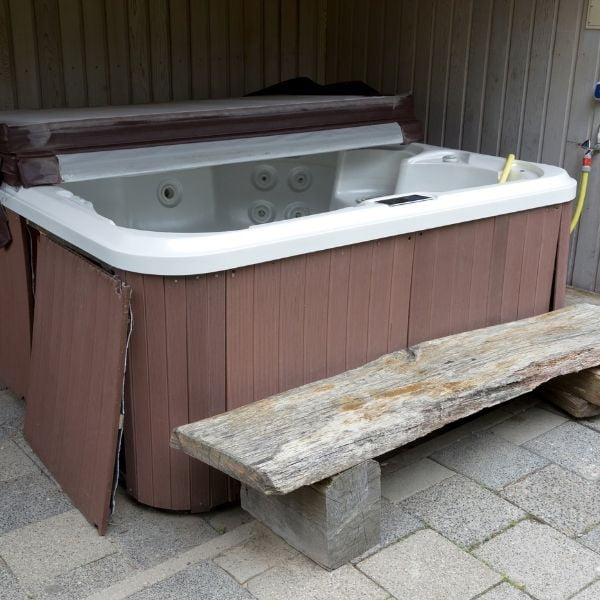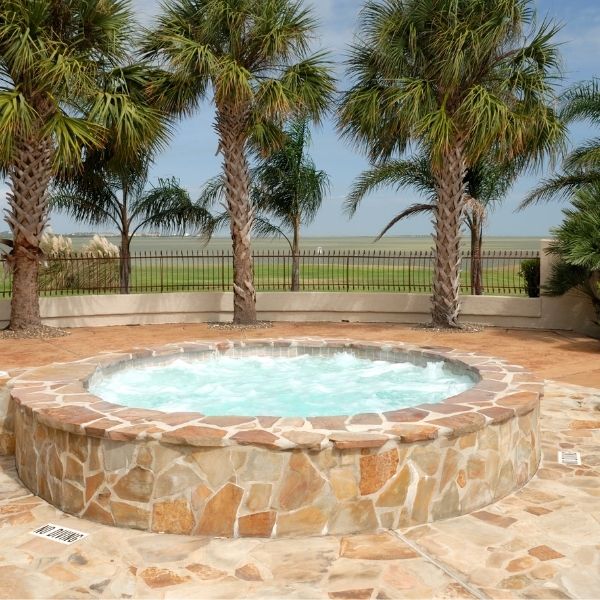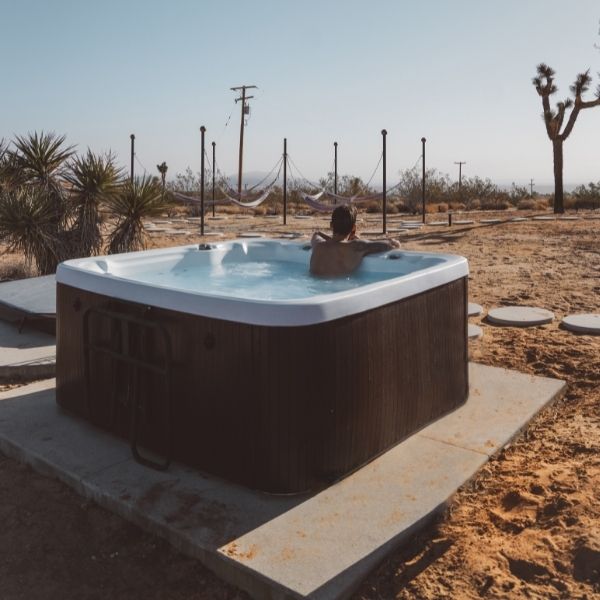In this post, we share the different options you have when it comes to choosing what to put under a hot tub. We also talk about their pros and cons, so you can decide which one is best for your needs.
You ordered your dream hot tub, and you start daydreaming about what it feels like soaking and being massaged in a whirlpool of warm water. But as you shift your gaze to the side, you began thinking, "Is my lawn good enough, or do I need a concrete pad?", "How about pavers, or perhaps a bed of sand or gravel?"
Luckily, you still have a couple of days to prepare before your hot tub arrives. Let's take a look at the different options available to you, and we'll talk about the pros and cons of each one. But first, let's talk about why you need the right kind of base for your type of hot tub.
What makes an ideal hot tub base?
If your hot tub is not on a stable base, it can shift or settle on one side, causing damage to your hot tub and your property. A good hot tub base will also protect your hot tub from moisture and pests.

- Perfectly even. First of all, you need a nice flat surface, so your hot tub is not tilted. An uneven surface puts tremendous stress on your hot tub's frame and shell, resulting in cracking or breaking. But if you still want to use the space, you can buy inexpensive solutions like wooden or plastic shims for slopes less than an inch.
- Provides water drainage. Keep your inflatable hot tub on a surface where water drains easily. Keeping the base dry prevents rotting and mildew, which could shorten your hot tub's life. A raised wooden platform provides good drainage—a bed of gravel or pavers layered with sand works well.
- Solid and firm. A hot tub can weigh up to a thousand pounds or more, water and people included, so you need a solid, stable base to ensure long use. We don't want our hot tub sinking or settling to one side or the other as this can cause many problems to your hot tub and your yard. Place your hot tub on a sturdy and firm surface. If you can't find one, you might consider building a wooden platform or pouring concrete.
Key Takeaways: Choose a perfect spot for your hot tub beforehand, ideally, one that is solid, flat, even, and has good drainage.
5 Great Hot Tub Base and Foundation Ideas
There are five types of hot tub base you can use to put your hot tub on, each having its qualities and characteristics to suit your needs: concrete, pavers, synthetic spa pads, gravel, and deck.


Best for durability: Gravel
Gravel is an excellent choice for a hot tub base because it's relatively cost-effective and easy to install. Crushed gravel offers the best of both worlds for a hot tub foundation - affordable and versatile. However, gravel can shift and move, so your spa must be installed by a professional
To create a gravel hot tub base, calculate the ground space your hot tub will take up. Mark out an area in your yard, dig a 6-inch-deep pit, line the bottom of the pit with landscape cloth, and fill the first four inches of the hole with medium-grade gravel. Top with smaller gravel like pea gravel, and rake until smooth.
Gravel is best for durability because it does not wear down easily. It's easy to clean and maintain and provides a natural cooling sensation, making it ideal for hot tub use in the summer months. It is also the best choice for drainage, keeping your hot tub base dry all year round, and ensuring good service for many years.
Best in most cases: Concrete
Concrete is a solid and durable choice for a hot tub base. It is permanent, and you'll need to hire contractors to install the pad (unless you're handy enough to do this yourself). Depending on where you live, you may also need a permit to install a concrete slab.
Concrete also needs the right mixture of cement and aggregates depending on the load (pounds per square inch) and has a curing period to achieve maximum strength. You can purchase a premix from your hardware store and, depending on your hot tub's total weight (water and people included), they'll recommend a specific premix for your concrete bed. You may also consider using rebars for good measure.


Creating a concrete base is very similar to that of a gravel base: you'll need to start with an excavated area big enough for the bottom of your hot tub, though you won't need to dig as deep — four inches suffice.
Finally, cover the bottom of the pit with about an inch of sand, then pour the entire amount of concrete over it. Smooth out the wet concrete with a board followed by a bull float, then trowel the surface after it begins to set.
Best for aesthetics: Pavers
Pavers/patio can be an excellent option for aesthetics if space is available. There is base prep work to be done before laying pavers, including excavation and leveling. Once you've chosen the style of pavers and designed the hot tub base, you need to build up several layers before putting them down.
Pavers are best for aesthetics, as they give a finished look that is usually invisible under spas. Building a paver patio can be more involved than constructing a concrete slab, but the end result will be attractive and supportive. If you're not actually planning to show much of the patio around the edges, pavers may not be worth your time as most of the finished result won't be visible.
Best for portability: Synthetic Spa Pad


Synthetic spa pads are a less permanent option for hot tub bases. They're strong and will support your spa but need an absolutely flat surface to lay them on. They're temporary and perfect for renters or people who can't make permanent changes to their property. The only downside is doesn't look as good as concrete, gravel, or pavers.
Best for the view: Deck
Decking is a popular feature to combine with hot tubs. However, it's important to make sure the deck is strong enough to support the weight of the hot tub. You'll need a professional to check if your deck can withstand the total weight of the hot tub. He may recommend adding joists or reinforcing your beams and columns.
As you might expect, this will cost you more than all the other options, but the view overlooking the city skyline or countryside will give you the best, most immersive experience involving all your senses. Another drawback to using decking is its lifespan, although this is less of an issue with new composites on the market.
Key Takeaways: Your choice of hot tub base will depend on your budget and personal preference. There's no one-size-fits-all, and each will have its own pros and cons, so weigh your options carefully before committing to one.
Conclusion
In conclusion, we want to ensure that you're getting the most out of your hot tub. Ultimately, it all depends on how you want to enjoy your hot tub and whether you're looking to use it as a spa or a relaxing place to unwind.
